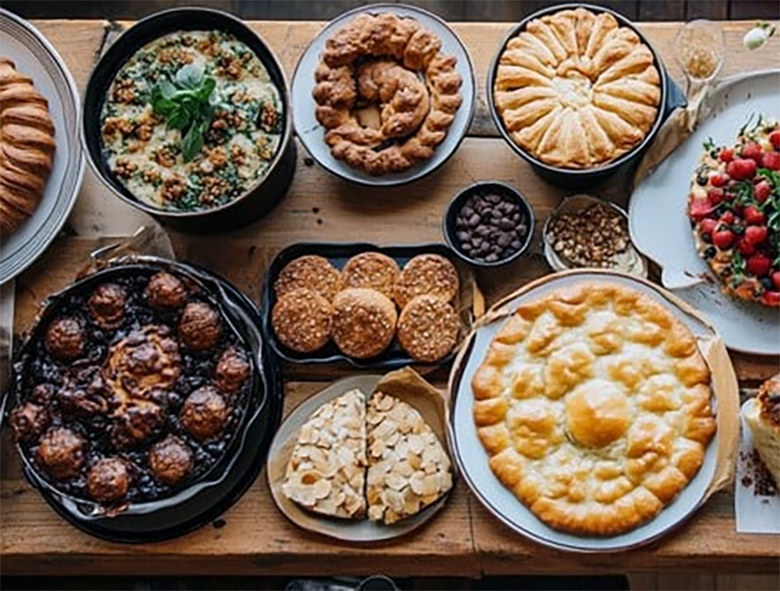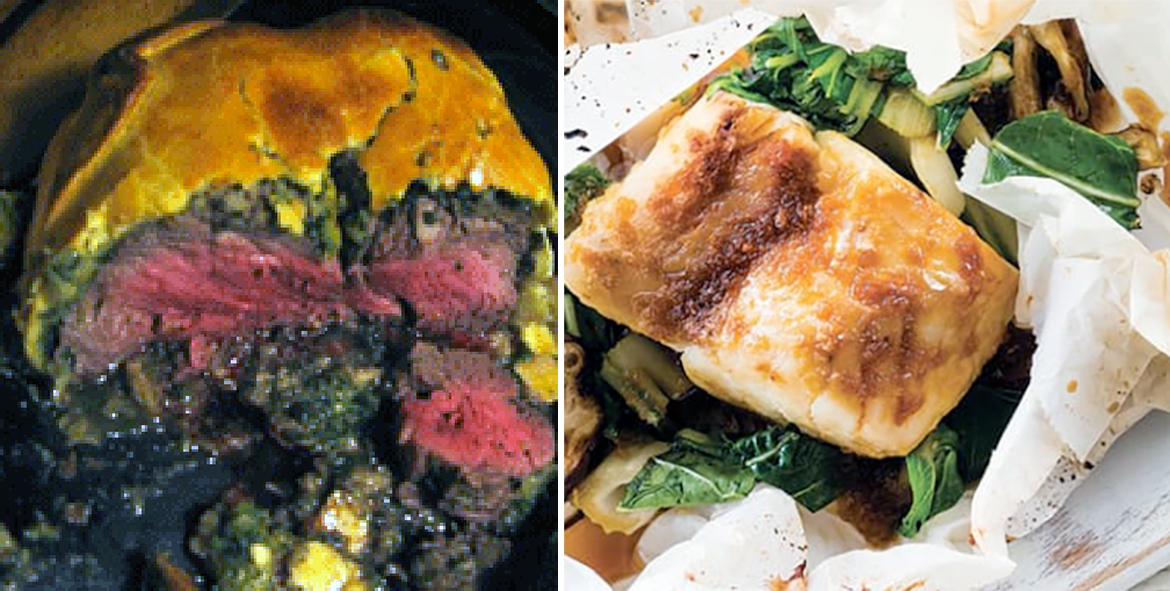FabulousFusionFood's Baking Recipes 15th Page
 A range of baked goods.
A range of baked goods.
Welcome to FabulousFusionFood's Baking Recipes Page — This is a continuation of an entire series of pages that will, I hope, allow my visitors to better navigate this site. As well as displaying recipes by name, country and region of origin I am now planning a whole series of pages where recipes can be located by meal type and main ingredient. This page gives a listing of all the baking recipes added to this site. Baking is defined as a technique for the prolonged cooking of food using dry heat by the action of conduction. Baking is normally done in an oven, but goods may also be baked in hot ashes or on hot stones. Baking differs from Roasting Recipes in that a lower temperature is typically used and the items are cooked for a longer period of time. Baking is a much older process than most people think and foods were probably originally baked in embers or with hot stones (which is how bread may have started). Only later did specialist ovens develop. Though most baked goods tend to be bread or cake-based some other dishes such as pasta dishes and vegetable dishes may also be baked. Stews are often also technically baked in an oven, but are not classed as 'baked goods' in that they are more liquid than solid at the end of the cooking process.
Baking is a method of preparing food that uses dry heat, typically in an oven, but can also be done in hot ashes, or on hot stones. The most common baked item is bread, but many other types of foods can be baked. Heat is gradually transferred "from the surface of cakes, biscuits and cookies, and pieces of bread to their centre, typically conducted at elevated temperatures surpassing 150°C. Dry heat cooking imparts a distinctive richness to foods through the processes of caramelization and surface browning. As heat travels through, it transforms batters and doughs into baked goods and more with a firm dry crust and a softer centre. Baking can be combined with grilling to produce a hybrid barbecue variant by using both methods simultaneously, or one after the other. Baking is related to barbecuing because the concept of the masonry oven is similar to that of a smoke pit.
In addition to bread, baking is used to prepare cakes, pastries, pies, tarts, quiches, biscuits and cookies, scones, crackers, pretzels, and more. These popular items are known collectively as 'baked goods', and are often sold at a bakery, which is a store that carries only baked goods, or at markets, grocery stores, farmers markets or through other venues.
 Beef en croûte (left) and fish en papillote (right).
Beef en croûte (left) and fish en papillote (right).
The alphabetical list of all the baking recipes on this site follows, (limited to 100 recipes per page). There are 2282 recipes in total:
Page 15 of 23
| Naples Bisket Origin: Britain | Old-fashioned Sponge Cake Origin: British | Pan di Spagna Origin: Italy |
| Navettes Bretonnes aux fruits rouges (Breton Navettes with Red Fruit) Origin: France | Old-fashioned Yule Cake Origin: Britain | Pan Loaf Bread Origin: Scotland |
| Nettle and Spinach Cake Origin: Britain | One-Two-Three-Four Cake Origin: American | Pane della colomba di Pasqua (Italian Easter Dove Bread) Origin: Italy |
| Neujahrsbrezel (New Year Pretzel) Origin: Germany | Onion-flavoured Potatoes Origin: Ireland | Panettone Origin: Italy |
| Neujahrspretzel (German New Year's Pretzels) Origin: Germany | Onions Stuffed with Meat and Mushrooms Origin: Czech | Panforte Origin: Italy |
| New Orleans Style Pumpkin Pie Origin: South Africa | Oozy Orange Cupcakes Origin: American | Panis cum Milo Fermento (Bread with Millet Leaven) Origin: Roman |
| New Potato Parcels Origin: Ireland | Orange and Poppy Seed Cupcakes Origin: Britain | Panis Quadratus (Four-cut Loaf) Origin: Roman |
| New York Cheesecake II Origin: America | Orange Breakfast Muffins (Orange Breakfast Muffins) Origin: Britain | Panlevi (Sponge Biscuits) Origin: Aruba |
| New Zealand Fish Pie Origin: New Zealand | Orange Chesecake Origin: Britain | Pão de Cacau (Chocolate Loaf) Origin: Sao Tome |
| New Zealand Kiwi Fruit Bread Origin: New Zealand | Orange Crumble Mince Pies Origin: Britain | Pão Doce Origin: Sao Tome |
| Newfoundland Bakeapple Cheesecake Origin: Canada | Orange Date Muffins (Orange Date Muffins) Origin: American | Papaya Fairy Cakes with Tangy Lemon Glaze Origin: African Fusion |
| Nigerian Meat Pasties Origin: Nigeria | Orange Marmalade Cupcakes Origin: Britain | Papaya Pudding Origin: Aruba |
| Nigerian Meat Pie Origin: Nigeria | Orange Olive Oil Cake Origin: Fusion | Paradise Cake Origin: Scotland |
| Nigerian Pancakes with Prawns Origin: Nigeria | Orange polenta cake Origin: Britain | Paratha Origin: India |
| Nigerian Sausage Rolls Origin: Nigeria | Orehnjaca (Walnut Roll) Origin: Croatia | Pargo con Tomate (Snapper with Tomato) Origin: Colombia |
| No Crust Easter Pie Origin: American | Orugli Vesak (Lemony Sponge Cake Dessert) Origin: Croatia | Parkin Origin: England |
| Normandy Cheesecake Origin: Britain | Ostkaka (Swedish Cheesecake) Origin: Sweden | Parkin Origin: England |
| Nthochi Bread (Banana Bread) Origin: Malawi | Oven Scones Origin: Scotland | Parmentier de Canard (Duck Parmentier) Origin: France |
| Nutella Swirl Banana Muffins Origin: Britain | Oven-baked Jam Roly Poly Origin: Britain | Parseli Brithyll a Thatws Cynnar (Trout and New Potato Parcels) Origin: Welsh |
| Oa Pnikta (Poached Egg in White Wine) Origin: Roman | Oven-baked Macaroni and Cheese Origin: American | Parseli Cennin (Leek Parcels) Origin: Welsh |
| Oat and Barley Milk Cakes Origin: Ancient | Oxtail Pot Pies Origin: South Africa | Parseli Ffilo Cennin a Chaws Caerffili (Leek and Caerphilly Cheese Parcels) Origin: Welsh |
| Oat and Currant Biscuits Origin: Britain | Pâo de Batata de Assadeira (Baked Potato Bread) Origin: Brazil | Parsley Pasty Origin: England |
| Oat Biscuits Origin: Britain | Pâté Cregyn Gleision y Fenai (Menai Straits Mussel Pâté) Origin: Welsh | Party Cupcakes Origin: Britain |
| Oat Scones Origin: Scotland | Pâte Sucrée (Sugar Pastry) Origin: France | Pasca de Pasti (Romanian Easter Cheesecake) Origin: Romania |
| Oatcakes Origin: Ancient | Pâtissons Farcis (Stuffed Squash) Origin: Mauritius | Paska Babka (Easter Babka) Origin: Belorussia |
| Oaten Bread Origin: Ireland | Pão de Aveia (Oat Bread) Origin: Brazil | Paska Babka (Easter Babka) Origin: Russia |
| Oatmeal Bilberry Bread Origin: Northern Ireland | Pão de Ervas (Herbed Sourdough Bread) Origin: Brazil | Paska Babka (Easter Babka) Origin: Ukraine |
| Oatmeal Cakes Origin: Scotland | Pain chapeau breton (Breton hat bread) Origin: France | Paska Bobka (Polish Easter Bread) Origin: Poland |
| Oatmeal Gingerbread Origin: Scotland | Pain de thon aux algues (Tuna and Seaweed Loaf) Origin: France | Paskalya Çöreği (Turkish Easter Bread) Origin: Turkey |
| Oatmeal Muffins (Oatmeal Muffins) Origin: American | Pain de Viande (Venison Meatloaf) Origin: Canada | Passion Cake Origin: Britain |
| Obuoliniai Sausainiai (Lithuanian Apple Biscuits) Origin: Lithuania | Pain du merlu á la laitue de mer (Hake and Sea Lettuce Loaf) Origin: France | Passion Fruit and Orange Butterfly Cakes Origin: Britain |
| Ofam (Ripe Plantain Loaf) Origin: Ghana | Pains aux Algues (Seaweed Loaf) Origin: France | Passion Fruit Soufflé Origin: Britain |
| Oggi Origin: Welsh | Palets Breton (Breton Pucks) Origin: France | |
| Old-fashioned Norfolk Sponge Cake Origin: British | Palets bretons au caramel salé (Breton Pucks with Salted Caramel) Origin: France |
Page 15 of 23